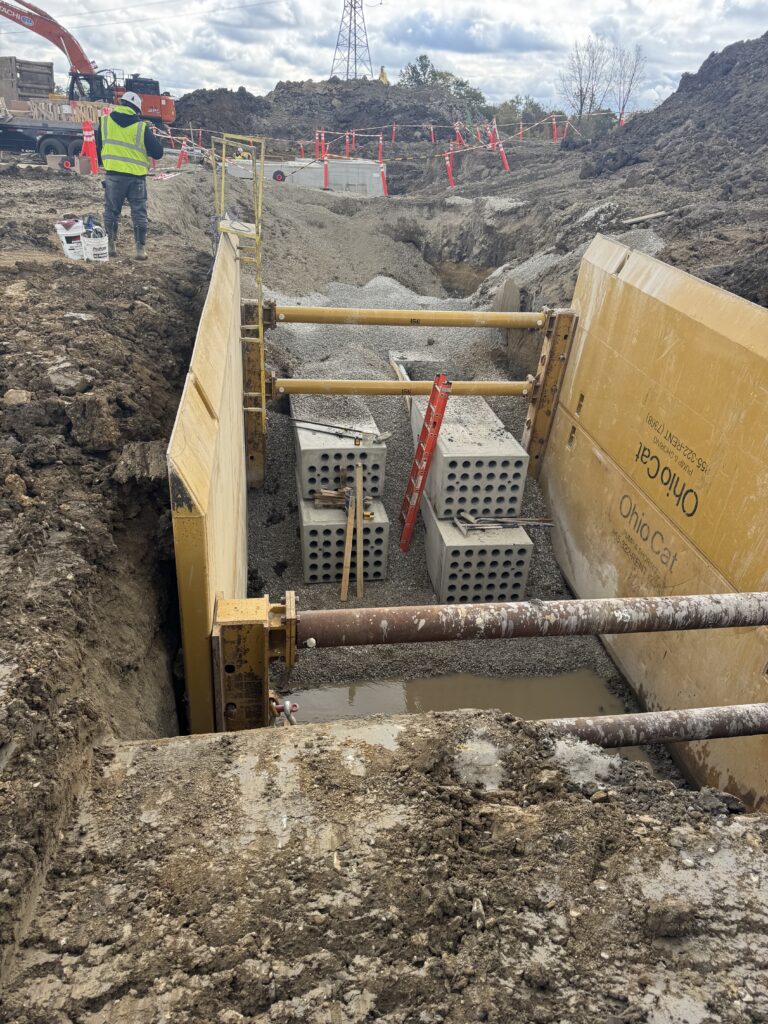Cast-in-place duct banks are familiar, but they’ve become a drag on safety, schedule, and profit. They eat labor, collapse timelines, and keep people in the trench longer than they need to be. Every GC and EC knows the routine — and every one of them would rather skip it.
Here’s what keeps going wrong on jobs that still pour in the field — and how DBO’s precast approach fixes it for good.
1. Too Many Hands in the Trench
A field-built duct bank pulls ten or more people into the same hole — electricians, laborers, and finishers all stacking up to tie rebar and align pipe before the pour. Productivity drops fast, and safety risk climbs with every extra body in the trench.
Prefabricated Duct Bank Advantage: Precast duct banks shift all that work offsite. Conduits, rebar, and concrete are already done in a controlled environment. On site, a small crew and an operator set modules by crane in minutes. Less labor, less risk, and fewer hours in the dirt.
2. Weather Runs the Schedule
Rain fills trenches. Heat cures concrete too fast. Cold slows it down. Field-built duct banks live at the mercy of weather — and every delay hits the critical path. You’re not just losing a day of work; you’re holding up energization, backfill, and paving.
Prefabricated Duct Bank Advantage: Precast duct banks are built under a roof and ready when you are. Set them in wet conditions, backfill the same day, and keep the project moving regardless of weather. The schedule belongs to the contractor again — not the forecast.
3. Safety Risks Pile Up
The longer a trench stays open, the more dangerous it gets. Cast-in-place work means people in the hole tying steel, gluing conduit, and managing a live pour around rebar and formwork. One bad wall or one distracted operator can turn it ugly fast.
Prefabricated Duct Bank Advantage: Precast cuts trench exposure to a fraction of what it was. Sections are lowered, aligned, and connected from the surface — no live pours, no finish work, no waiting on cure. It’s safer by design because the riskiest work happens somewhere else.
4. Quality You Can’t Repeat
No two field-built duct banks ever look the same. Conduits shift, spacing changes, and consolidation varies from pour to pour. You don’t notice until cables bind during pull or insulation starts running hot years later.
Prefabricated Duct Bank Advantage: In DBO’s plant, precision jigs and laser-cut forms lock every conduit in place before concrete touches the mold. Every section is poured, cured, and tested to spec — so what you get on site is predictable, repeatable, and built to perform.
5. Time You’ll Never Get Back
Between formwork, pour, cure, and inspection, a 100-foot cast-in-place run can eat three weeks of schedule — and that’s if the weather cooperates. Everyone downstream waits.
Prefabricated Duct Bank Advantage: Precast duct banks turn a three-week process into a two-day install. While your crews trench, DBO is already pouring. When the trench opens, modules drop in and backfill starts. It’s construction in parallel, not in sequence.
A Scope Ready for Change
Traditional duct banks tie up your best people, slow your critical path, and add risk you don’t need. DBO takes that chaos off the jobsite. Precast modules arrive complete, aligned, and ready to go — no rebar cages, no weather hold, no trench full of bodies.
That’s why owners, GCs, and ECs are done pouring duct banks in the field. They’re done building them. They’re buying them.



